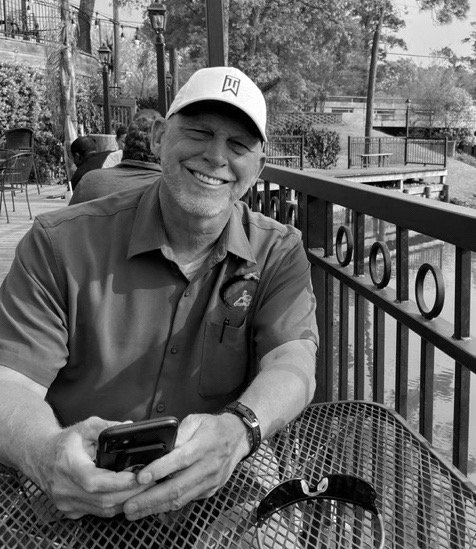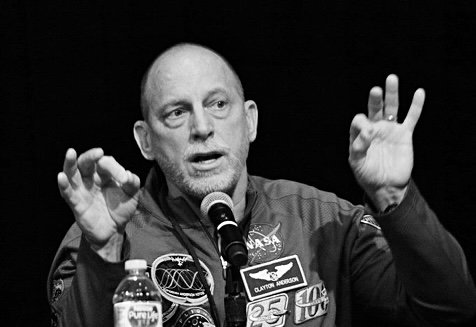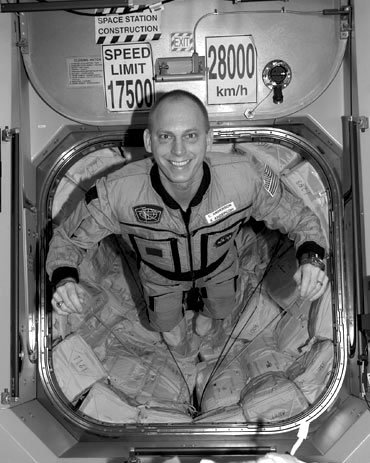Meet Clayton Anderson
Clayton Anderson doesn’t take no for an answer, at least he winces at the word. Fourteen years in a row, he applied to become an astronaut. Fourteen years in a row NASA said no. Actually for most of those years NASA didn’t even bother to say no. They just ignored his applications. Then one day in 1998, he got a call …
I mean, I understand the dictionary definition when I hear the word “no,” the hardest part was accepting it from NASA. For much of my life and career people told me no, you’ll never be an astronaut. It wasn’t that I was too young to be an astronaut when I started applying, I was too unaccomplished. I didn’t have a PhD. I hadn’t discovered a new chemical element. I hadn’t invented a new software for use in space. I hadn’t flown a fighter jet in war and shot down the enemy. I was just a kid from Ashland, Nebraska plugging away as an engineer at the Johnson Space Center.
I started working at the Johnson Space Center in 1983 after college. I have a masters of science in engineering degree from Iowa State. When I got to the Johnson Space Center, we were studying designs for the new space station which would become the International Space Center. I was happy doing that, but my goal was to become an astronaut though, and I started sending in my application. I heard no a lot, but I was pretty true to my goals and my beliefs and ideals. I would not give up my dream.
I remember when I was nine years old, my parents got my sister and brother and me and put us in front of a black and white TV. We watched the Apollo 8 guys go behind the moon for the first time. When they went behind the moon, there was no more communication which kind of freaked me out. When they came around the other side and we could hear them again, that was pretty cool to me and that was my moment of wanting to be an astronaut. I wanted to do that!
My mom will tell you that when I was six I told her that I’d be an astronaut one day. My hometown of Ashland, Nebraska had a summer parade, a kiddie parade they called it, and all the kids put on costumes and marched. There was no Walmart or Costco or Target back then, so my mom got a hat box and she cut a slot for my eyes and a hole for my head. She put a pipe cleaner in a Styrofoam ball on top so I could communicate with aliens. She wrapped everything including me in aluminum foil. I walked in that parade as a Mercury astronaut. I failed there, too. I didn’t win a prize for my costume.
I applied to be an astronaut 14 years in a row. The way the process worked when I first applied in 1983, you submitted your paperwork and you got a postcard back that said we have received your application and that was pretty much it. The only time you got a rejection letter, or any indication they were even considering you, was an invitation to be interviewed. So I didn’t get a letter of rejection or anything. On the 13th try, I finally got an interview but didn’t get accepted. That was the first time I got an actual letter of rejection. The 14th year I applied they didn’t accept any new candidates. That was the rule, even if they weren’t taking any new astronauts, they still expected you to apply. On my 15th try, by now it was 1998, I was interviewed again and this time I got a call from the NASA boss saying yes!
I left my job as an engineer and reported to astronaut school at the Johnson Space Center. I was a “baby astronaut,” a term I believe I coined at NASA, and started training. I was picked in 1998 and didn’t go up until 2007. It was really frustrating. But that was the norm. As a baby Astronaut I was doing the jobs the real astronauts didn’t want to do, like writing procedures, what to do in case of a fire or what to do if there’s an ammonia leak. At the time there were no formal procedures for things like that.
When the class of 1998, my class, started getting their assignments to fly it became real to me, and more competitive, and more tense. They’re always looking at you, somebody’s always watching you, ranking you, making notes about you. They’ve got their eyeball on you, so you don’t want to mess up.
I got a call from one of the deputies in the office saying, hey are you still interested in flying long duration? I said yes, whatever would get me into space the fastest. I knew that was my destiny, to be on a long duration mission.
On my first mission I was in space 151 days, 18 hours 14 minutes and 23 seconds, give or take a second. I was shuttled to the International Space Station with two Russian cosmonauts. Back then, the International Space Station was the size of a 3-bedroom house with a couple of tiny baths and a cooking area. They’ve added a module so now it’s about the size of a 4-bedroom house with a second cooking area. I ate mostly prepared meals or Army field meals which weren’t too bad, actually pretty good. The Russians had better food in cans. It was like eating Dinty Moore, which everybody loves.
We had work to do, even on Saturday which was supposedly cleaning day with half the day off. Sunday was off but you still had to exercise. Typically I wore shorts and a T-shirt. If I knew I was going to be on NASA TV, I put on a Polo shirt and a pair of pants. During my time up there, I spoke with Craig Biggio and congratulated him on his 3,000th hit.
We had TV but not like cable today. I love football so I got to watch my University of Nebraska Cornhuskers if they played on a network. The boredom got to me occasionally. I found myself trying to play the Tiger Woods video game on a laptop computer but I couldn’t get it to work. By the time I managed to get it loaded four hours later, I sucked at it because I didn’t have controllers to play it the right way. I wasted all that time.
You’re allowed to take some personal items into space as long as they’re small and foldable and don’t weigh much. Bill Gates’ family asked me to take some gold coins but you’re not allowed to bring money, and I wound up taking some Toy Story DVDS for them. I took some things for myself, like my wife’s and my wedding rings.
You go around the Earth every 90 minutes so you see 16 sunrises and 16 sunsets every day. No, you can’t see the Great Wall of China with your naked eye. But I was on TV one morning with Larry the Cable Guy, who’s also from Nebraska and he asked me if I could see Al Roker from space.
I believe in having fun. When I was in space, I was the guy who put boxer shorts on his head. I was the guy who wore furry boots and played Super Hero. I was the guy who called down with trivia questions. Did they see humor in this back at NASA? Heck no!
You do get a little taller in space because there’s no gravity working on your spine. But you go back to your regular height when you land on Earth. I lost 12 pounds in space. Your body says, I’m in a weird place I’m going to get rid of what I don’t need. But I put that back on, too.
We had regular medical and psych consultations with doctors on the ground, which were supposed to be private, not sure they were. The mental tedium got to me and I got frustrated with the ground people. I yapped at them and they yapped back at me, which was frowned upon. They don’t tolerate back talk very well. They put a red X by my name for future opportunities. When I returned to Earth, I was on probation and didn’t get to fly again until 2010. When I got back from that mission, which was 15 days, I was told I wouldn’t fly again. They just wanted me to teach and go to meetings. I’m not a meetings guy, so I resigned in 2013. Now I spend time giving motivational talks, I’ve written my memoir and spending time with my family.
At the end of my 15 years as an astronaut I had done everything I dreamed about, and things I never imagined. I flew in space! During training, I lived underwater for two weeks. I climbed mountains. I camped out in winter. I visited countries around the world.
I call myself the Ordinary Astronaut because I grew up in Nebraska playing baseball on the sandlots and hoops in the school gym at night. I tell kids to keep trying no matter what anybody tells you. If they say you’re not good enough, don’t listen to them. Keep at it. I never was supposed to be an astronaut and fly in space. But I never gave up. I’m just an ordinary guy who had extraordinary perseverance.





